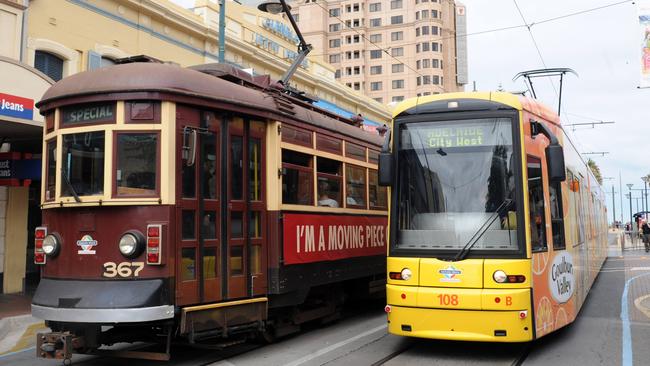AdeLINK: State Government, councils, transport experts meet to discuss Adelaide tram network
UPDATE: Councils prepared to come to the table with more co-funding for a tram network will have work in their area prioritised, the Transport Minister has revealed at a summit held at Town Hall this morning.
SA News
Don't miss out on the headlines from SA News. Followed categories will be added to My News.
COUNCILS prepared to come to the table with more co-funding for a tram network will have work in their area prioritised, the Transport Minister has revealed at a summit held at Town Hall this morning.
But councils are likely to rely heavily on their ratepayers for funding.
A “value capture scheme” — a hot topic at today’s light rail summit — essentially means ratepayers, property owners and developers who benefit from the introduction of trams to their area will help subsidise the build.
“We’ve certainly had a clear indication from the Federal Government that they don’t expect that it will only be the state … and Federal Government who will be funding these infrastructure improvements,” Transport Minister Stephen Mullighan told more than 100 delegates.
“They want opportunities explored to capture some of the benefits that communities will experience from this infrastructure, and have those benefits captured in a way that they can contribute to the delivery of these tram extension projects.”
Technical director of services firm AECOM and infrastructure specialist Joe Langley told delegates that property prices in areas of major infrastructure builds could rise by more than 10 per cent.
Mr Mullighan confirmed that councils with money on the table would be first in line for trams.
“Importantly what you are seeing today for the first time is local government inside the tent willing to sit around the table, willing to put the effort into those plans and ... willing to put the effort in through financial contributions to bringing these projects out.” Mr Mullighan said.
“If we have a council that says we are ready to go and ready to commit, well obviously the extension that heads towards their area will become a priority.”
The State Government has spent $4 million investigating the feasibility of a new tram network.
Federal MP Anthony Albanese earlier this month said an elected Labor Government would work with the state to ensure the project became a reality.
The AdeLINK plan includes:
EASTLINK — extending east through Kent Town to The Parade;
WestLINK — following Henley Beach Road to Henley Square, with a branch line to
Adelaide Airport;
ProspectLINK — following O’Connell Street to Prospect Road;
UnleyLINK — following Unley Road and Belair Road to Mitcham;
CITYLINK — following a continuous loop around the city; and
PortLINK — using the existing Outer Harbor line with services to Port Adelaide,
West Lakes and Semaphore.

Adelaide had an extensive tram network covering all quarters of the city and inner suburbs until it was ripped up in the 1950s to make way for buses and cars.
Property Council Executive Director Daniel Gannon said there was an alternative financing mechanism to value capture, called a City Deal.
Under this plan, all tiers of government would sign long-term contracts to deliver major infrastructure projects, while setting targets for the jobs created as a result, and also other economic measures.
“Value capture was a hot topic, and that mechanism is generally used in reference to a single piece of infrastructure and how it affects land values and therefore land based tax revenues,” Mr Gannon said.
“In other words, if you build a tram line, the properties near a tram station will increase in value and therefore pay more in council rates and land taxes.
“A City Deal isn’t one singular project, but potentially hundreds. It’s an entire program of infrastructure for a designated region.
“The idea is that if you prioritise the infrastructure program across multiple governments you’ll grow the economy in total, not just increase some land values near a single project like a tram stop. That means the total tax take will increase off the back of a stronger economy, not just land based taxes, and this additional tax can be used to pay off debt.”
Funding will play the most important issue with Mr Mullighan telling The Advertiser that the new rail network wouldn’t come cheap.
“When you think about if we delivered all the possible (AdeLINK) projects together it would be a very major undertaking — the amount of expenditure would be enormous,” he said.
“It would be well in excess of $1 billion to deliver all of these tram lines but it’s absolutely imperative that we continue on with the work that we started with the two tram extensions we’ve done to date.”
Lord Mayor Martin Haese said the outcomes and benefits of an extended tram network were clear.
“I think there’s a pretty strong link between transport outcomes and economic development,” he said.
“For example — if we put a tram a long North Tce — undoubtedly everything would change — use that analogy for Prospect Rd or for any other road and I think the same logic would play out That’s what we want to quantify.”
Mr Mullighan said public perception of trams returning to Adelaide had changed since the success of the city extension which was completed in 2007 and continued down to Port Rd in 2010.
“When we announced in 2005 that we would be extending the Glenelg tram past Victoria Square to the railway station there howls of protest against it,” he said.
“I think we’ve managed to completely flip the public debate from being against these sorts of projects to be being very strongly in favour.”


